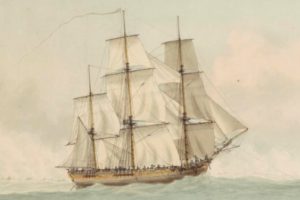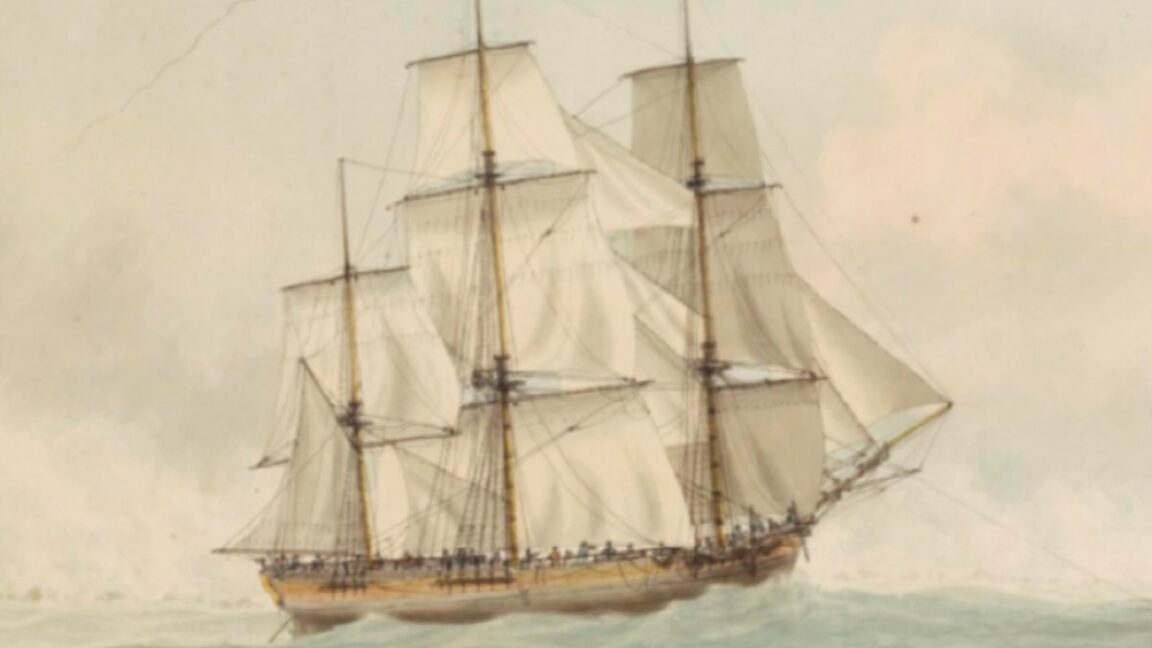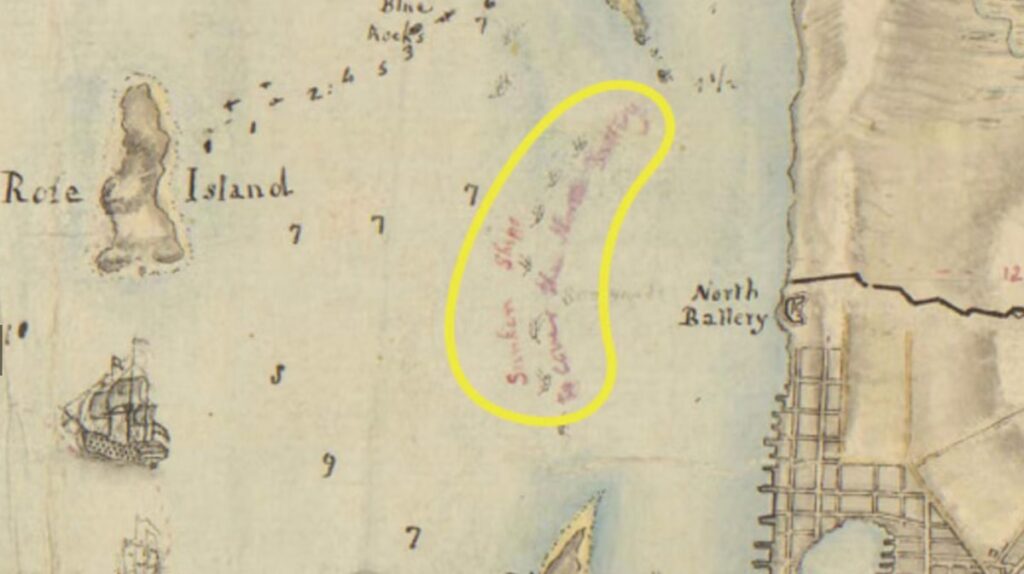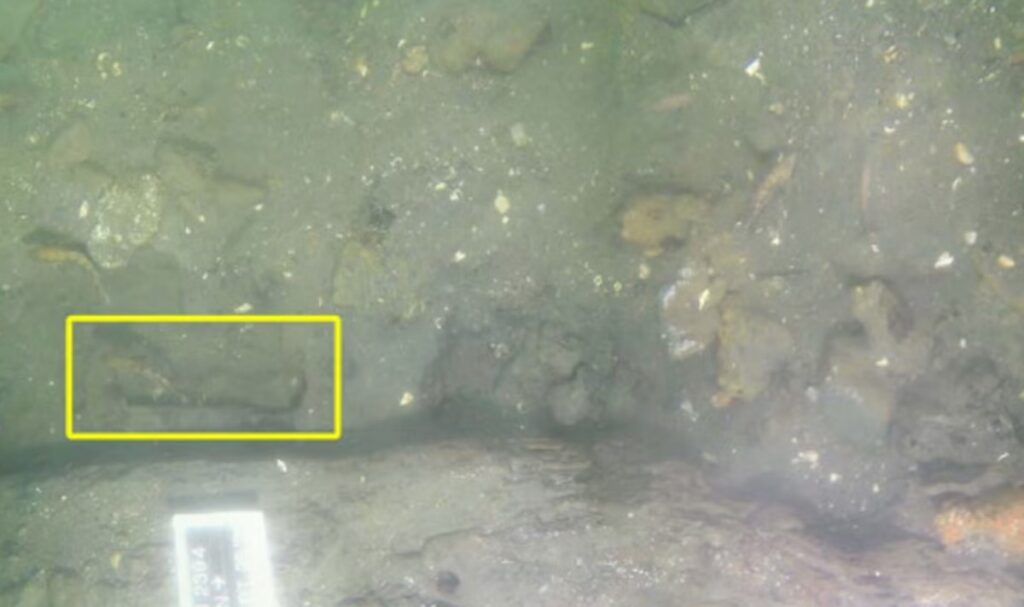- Регистрация
- 17 Февраль 2018
- Сообщения
- 38 866
- Лучшие ответы
- 0
- Reactions
- 0
- Баллы
- 2 093
Offline
“The timbers are British timbers. The size of all the timber scantlings are almost identical to Endeavour."


Painting by Samuel Atkins of the HMS Endeavour off the coast of New Holland during Cook's voyage of discovery (1768-1771). Credit: Public domain
Back in 2022, we reported on the Australian National Maritime Museum's (ANMM) announcement that its researchers had confirmed that a shipwreck proposed as a likely candidate in 2018 is indeed the remains of the HMS Endeavour. However, the Rhode Island Marine Archaeology Project (RIMAP)—the museum's research partner in the project—promptly released a statement calling the announcement premature. RIMAP insisted that more evidence was needed.
The final report is now available, and both RIMAP and ANMM say they have confirmed that the wreck is indeed the Endeavour. (You can read the full report here.) “The timbers are British timbers. The size of all the timber scantlings are almost identical to Endeavour, and I’m talking within millimeters—not inches, but millimeters," Kieran Hosty, an ANMM archaeologist who co-wrote the report, told The Independent. “The stem scarf is identical, absolutely identical. This stem scarf is also a very unique feature—we’ve gone through a whole bunch of 18th-century ships' plans, and we can’t find anything else like it.”
As previously reported, Endeavour Captain James Cook's first voyage (1768–1771) was, in part, a mission to observe and record the 1769 transit of Venus across the Sun. The observation was part of a combined global effort to determine the distance of the Earth from the Sun. Those observations proved less conclusive than had been hoped, but during the rest of the voyage, Cook was able to map the coastland of New Zealand before sailing west to the southeastern coast of Australia—the first record of Europeans on the continent's Eastern coastline.
The Endeavour (by then renamed the Lord Sandwich) met its demise in the Atlantic when it was one of 13 ships the British deliberately sank (or "scuttled") in a Rhode Island harbor during the American Revolution. Archaeologists and divers in 1993 consulted 18th-century maps and logs for information about the locations of the wrecks of the Endeavour and the other ships scuttled with it. Then the researchers took to the water with side-scan sonar to find the remains.
By 2016, RIMAP's volunteers, operating on grants and private donations, had located 10 of the 13 wrecks, almost exactly where historical charts said they should be. And the search had gotten a boost from the 1998 discovery of a 200-year-old paper trail linking the troop transport Lord Sandwich to its former life as HMS Endeavour.
Narrowing the field

Edward Fage, [Newport and its environs, ca. 1778], William L. Clements Library, University of Michigan, 8380. Note ‘Sunken Ships’ indicated due west of North Battery (circled). Australian National Maritime Museum

Mosaic showing frame and scuttling hole beneath letter board, north is at bottom of image. John D. Broadwater/Australian National Maritime Museum
Edward Fage, [Newport and its environs, ca. 1778], William L. Clements Library, University of Michigan, 8380. Note ‘Sunken Ships’ indicated due west of North Battery (circled). Australian National Maritime Museum
Mosaic showing frame and scuttling hole beneath letter board, north is at bottom of image. John D. Broadwater/Australian National Maritime Museum
One candidate was found just 500 meters off the coast of Rhode Island (designated RI 2394), 14 meters below the surface and buried in nearly 250 years' worth of sediment and silt. RIMAP's team concluded in 2018 that this was likely the wreck of the Endeavour, although the researchers emphasized that they needed to accumulate more evidence to support their conclusions. That's because only about 15 percent of the ship survived. Any parts of the hull that weren't quickly buried by silt have long since decomposed in the water.
The ANMN felt confident enough in its own research by 2022 to hold that controversial news conference announcing the discovery, against RIMAP's objections. But the evidence is now strong enough for RIMAP to reach the same conclusion. "In 1999 and again in 2019, RIMAP and ANMM agreed on a set of criteria that, if satisfied, would permit identification of RI 2394 as Lord Sandwich," the authors wrote in the report's introduction. "Based on the agreed preponderance of evidence approach, enough of these criteria have now been met... to positively identify RI 2394 as the remnants of Lord Sandwich, formerly James Cook’s HM Bark Endeavour. "
The Rhode Island Historical Preservation and Heritage Commission and the ANMM are now collaborating to ensure that the wreck site is protected in the future.


Painting by Samuel Atkins of the HMS Endeavour off the coast of New Holland during Cook's voyage of discovery (1768-1771). Credit: Public domain
Back in 2022, we reported on the Australian National Maritime Museum's (ANMM) announcement that its researchers had confirmed that a shipwreck proposed as a likely candidate in 2018 is indeed the remains of the HMS Endeavour. However, the Rhode Island Marine Archaeology Project (RIMAP)—the museum's research partner in the project—promptly released a statement calling the announcement premature. RIMAP insisted that more evidence was needed.
The final report is now available, and both RIMAP and ANMM say they have confirmed that the wreck is indeed the Endeavour. (You can read the full report here.) “The timbers are British timbers. The size of all the timber scantlings are almost identical to Endeavour, and I’m talking within millimeters—not inches, but millimeters," Kieran Hosty, an ANMM archaeologist who co-wrote the report, told The Independent. “The stem scarf is identical, absolutely identical. This stem scarf is also a very unique feature—we’ve gone through a whole bunch of 18th-century ships' plans, and we can’t find anything else like it.”
As previously reported, Endeavour Captain James Cook's first voyage (1768–1771) was, in part, a mission to observe and record the 1769 transit of Venus across the Sun. The observation was part of a combined global effort to determine the distance of the Earth from the Sun. Those observations proved less conclusive than had been hoped, but during the rest of the voyage, Cook was able to map the coastland of New Zealand before sailing west to the southeastern coast of Australia—the first record of Europeans on the continent's Eastern coastline.
The Endeavour (by then renamed the Lord Sandwich) met its demise in the Atlantic when it was one of 13 ships the British deliberately sank (or "scuttled") in a Rhode Island harbor during the American Revolution. Archaeologists and divers in 1993 consulted 18th-century maps and logs for information about the locations of the wrecks of the Endeavour and the other ships scuttled with it. Then the researchers took to the water with side-scan sonar to find the remains.
By 2016, RIMAP's volunteers, operating on grants and private donations, had located 10 of the 13 wrecks, almost exactly where historical charts said they should be. And the search had gotten a boost from the 1998 discovery of a 200-year-old paper trail linking the troop transport Lord Sandwich to its former life as HMS Endeavour.
Narrowing the field

Edward Fage, [Newport and its environs, ca. 1778], William L. Clements Library, University of Michigan, 8380. Note ‘Sunken Ships’ indicated due west of North Battery (circled). Australian National Maritime Museum

Mosaic showing frame and scuttling hole beneath letter board, north is at bottom of image. John D. Broadwater/Australian National Maritime Museum
Edward Fage, [Newport and its environs, ca. 1778], William L. Clements Library, University of Michigan, 8380. Note ‘Sunken Ships’ indicated due west of North Battery (circled). Australian National Maritime Museum
Mosaic showing frame and scuttling hole beneath letter board, north is at bottom of image. John D. Broadwater/Australian National Maritime Museum
One candidate was found just 500 meters off the coast of Rhode Island (designated RI 2394), 14 meters below the surface and buried in nearly 250 years' worth of sediment and silt. RIMAP's team concluded in 2018 that this was likely the wreck of the Endeavour, although the researchers emphasized that they needed to accumulate more evidence to support their conclusions. That's because only about 15 percent of the ship survived. Any parts of the hull that weren't quickly buried by silt have long since decomposed in the water.
The ANMN felt confident enough in its own research by 2022 to hold that controversial news conference announcing the discovery, against RIMAP's objections. But the evidence is now strong enough for RIMAP to reach the same conclusion. "In 1999 and again in 2019, RIMAP and ANMM agreed on a set of criteria that, if satisfied, would permit identification of RI 2394 as Lord Sandwich," the authors wrote in the report's introduction. "Based on the agreed preponderance of evidence approach, enough of these criteria have now been met... to positively identify RI 2394 as the remnants of Lord Sandwich, formerly James Cook’s HM Bark Endeavour. "
The Rhode Island Historical Preservation and Heritage Commission and the ANMM are now collaborating to ensure that the wreck site is protected in the future.
